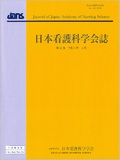Japanese
English
- 販売していません
- Abstract 文献概要
- 参考文献 Reference
要旨
目的:看護提供方式としてのパートナーシップ・ナーシング・システム(PNS)の看護特性を数理モデルによって定量的に評価した.
方法:確率過程の数理モデルを使い,看護提供の受付け口数の違いが患者の看護待ち行列数に及ぼす効果を調べた.さらにベテランナースと新人ナースがペアを組み看護ケアを分担する場合の看護ケア効率を調べた.
結果:看護待ち行列の平均人数は,看護提供の受付け口数が2から1に半減すると,トラフィック密度に依存し,およそ10倍に増え,患者に厳しい負担を与えることになった.さらに,ベテランナースと新人ナースが看護ケアを分担すると,単独で行う場合に比べ,看護ケア効率が落ちた.
結論:PNSの2つの構造的特性は,ナースが単独での看護提供に比較して不利な結果となった.PNSが患者に,より安全で質の高い看護サービスを効率よく提供するためには,ナース間で高度なコミュニケーションを図り,互いを補完し協働することが必要である可能性が残された.
Objective: This study aimed to evaluate quantitatively some of the fundamental characters of the Partnership Nursing System (PNS) as a nursing care delivery system.
Method: Using the mathematical model of Stochastic process we investigated the influence of the difference in the number of care delivery for patients at a time (the number of reception windows) on the number of patients waiting for nursing care (patients' queue length). Furthermore, we investigated the care efficiency when an expert nurse and a beginner nurse provided nursing care together as a pair.
Results: The average number of patients waiting for nursing care increased about 10 times, depending on the traffic density as the number of reception windows decreased by half from two to one. This result showed that the PNS imposed severe burden on patients. Further, when an expert nurse and a beginner nurse provided nursing care together as a pair, the care efficiency decreased compared to the case of each nurse providing care alone.
Conclusion: The two structural characters of PNS made PNS disadvantage compared to the case where each nurse gave nursing care separately. It was suggested that for PNS to be effective, the possibility remains which the joint co-operation is necessary, accompanied by intense communication.
Copyright © 2021, Japan Academy of Nursing Science. All rights reserved.


